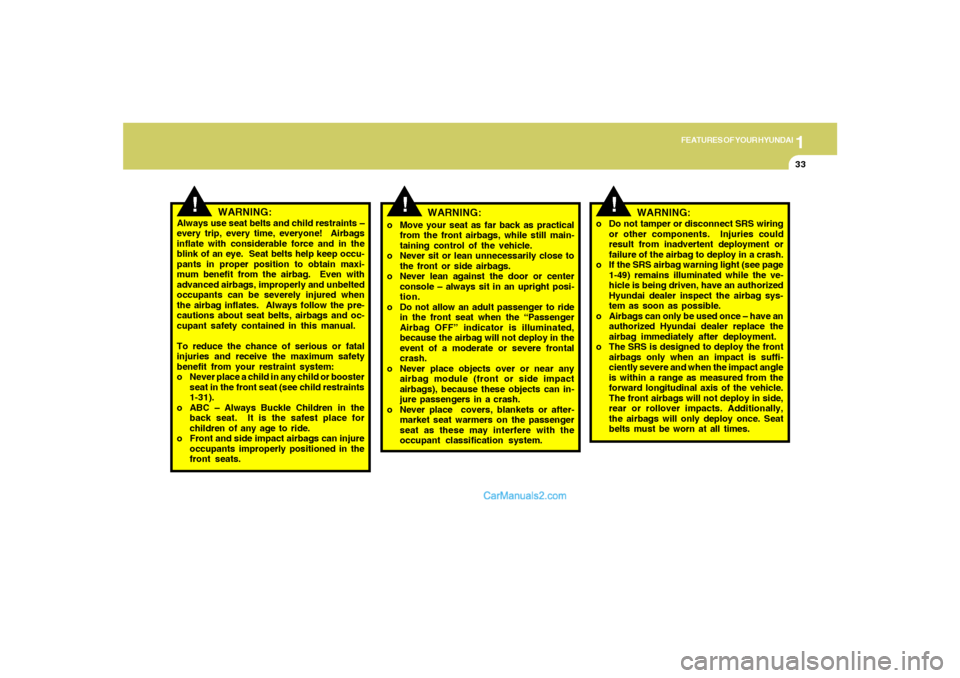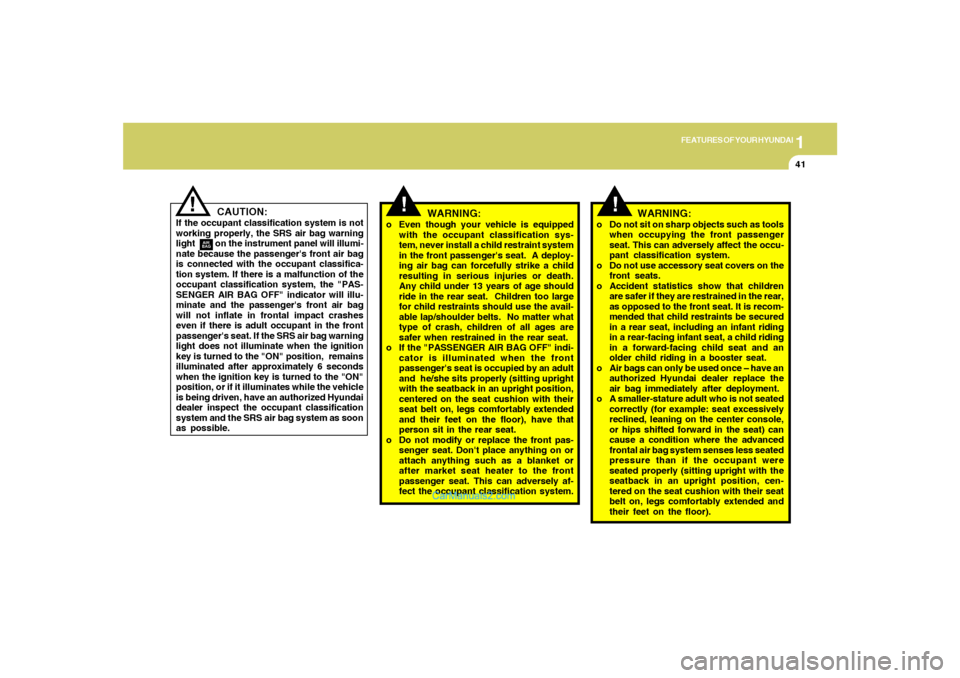center console Hyundai Tiburon 2008 Owner's Manual
[x] Cancel search | Manufacturer: HYUNDAI, Model Year: 2008, Model line: Tiburon, Model: Hyundai Tiburon 2008Pages: 268, PDF Size: 9.93 MB
Page 45 of 268

1
FEATURES OF YOUR HYUNDAI
33
!
WARNING:
o Move your seat as far back as practical
from the front airbags, while still main-
taining control of the vehicle.
o Never sit or lean unnecessarily close to
the front or side airbags.
o Never lean against the door or center
console – always sit in an upright posi-
tion.
o Do not allow an adult passenger to ride
in the front seat when the “Passenger
Airbag OFF” indicator is illuminated,
because the airbag will not deploy in the
event of a moderate or severe frontal
crash.
o Never place objects over or near any
airbag module (front or side impact
airbags), because these objects can in-
jure passengers in a crash.
o Never place covers, blankets or after-
market seat warmers on the passenger
seat as these may interfere with the
occupant classification system.
!
WARNING:
Always use seat belts and child restraints –
every trip, every time, everyone! Airbags
inflate with considerable force and in the
blink of an eye. Seat belts help keep occu-
pants in proper position to obtain maxi-
mum benefit from the airbag. Even with
advanced airbags, improperly and unbelted
occupants can be severely injured when
the airbag inflates. Always follow the pre-
cautions about seat belts, airbags and oc-
cupant safety contained in this manual.
To reduce the chance of serious or fatal
injuries and receive the maximum safety
benefit from your restraint system:
o Never place a child in any child or booster
seat in the front seat (see child restraints
1-31).
o ABC – Always Buckle Children in the
back seat. It is the safest place for
children of any age to ride.
o Front and side impact airbags can injure
occupants improperly positioned in the
front seats.
!
WARNING:
o Do not tamper or disconnect SRS wiring
or other components. Injuries could
result from inadvertent deployment or
failure of the airbag to deploy in a crash.
o If the SRS airbag warning light (see page
1-49) remains illuminated while the ve-
hicle is being driven, have an authorized
Hyundai dealer inspect the airbag sys-
tem as soon as possible.
o Airbags can only be used once – have an
authorized Hyundai dealer replace the
airbag immediately after deployment.
o The SRS is designed to deploy the front
airbags only when an impact is suffi-
ciently severe and when the impact angle
is within a range as measured from the
forward longitudinal axis of the vehicle.
The front airbags will not deploy in side,
rear or rollover impacts. Additionally,
the airbags will only deploy once. Seat
belts must be worn at all times.
Page 51 of 268

1
FEATURES OF YOUR HYUNDAI
39
- Never excessively recline the front passen-
ger seatback.
1KMN3665
1KMN3662
- Never place feet on the dashboard.
- Never sit with hips shifted towards the front
of the seat.
1KMN3663
1KMN3664
- Never place feet on the front passenger
seatback.
OVQ036014N
- Never put a heavy load in the front passen-
ger seat or seatback pocket.
OVQ036013N
- Never lean on the center console.
- Never sit on one side of the front passenger
seat.
Page 53 of 268

1
FEATURES OF YOUR HYUNDAI
41
!
!
CAUTION:
If the occupant classification system is not
working properly, the SRS air bag warning
light
on the instrument panel will illumi-
nate because the passenger's front air bag
is connected with the occupant classifica-
tion system. If there is a malfunction of the
occupant classification system, the "PAS-
SENGER AIR BAG OFF" indicator will illu-
minate and the passenger's front air bag
will not inflate in frontal impact crashes
even if there is adult occupant in the front
passenger's seat. If the SRS air bag warning
light does not illuminate when the ignition
key is turned to the "ON" position, remains
illuminated after approximately 6 seconds
when the ignition key is turned to the "ON"
position, or if it illuminates while the vehicle
is being driven, have an authorized Hyundai
dealer inspect the occupant classification
system and the SRS air bag system as soon
as possible.
!
WARNING:
o Even though your vehicle is equipped
with the occupant classification sys-
tem, never install a child restraint system
in the front passenger's seat. A deploy-
ing air bag can forcefully strike a child
resulting in serious injuries or death.
Any child under 13 years of age should
ride in the rear seat. Children too large
for child restraints should use the avail-
able lap/shoulder belts. No matter what
type of crash, children of all ages are
safer when restrained in the rear seat.
o If the "PASSENGER AIR BAG OFF" indi-
cator is illuminated when the front
passenger's seat is occupied by an adult
and he/she sits properly (sitting upright
with the seatback in an upright position,
centered on the seat cushion with their
seat belt on, legs comfortably extended
and their feet on the floor), have that
person sit in the rear seat.
o Do not modify or replace the front pas-
senger seat. Don't place anything on or
attach anything such as a blanket or
after market seat heater to the front
passenger seat. This can adversely af-
fect the occupant classification system.o Do not sit on sharp objects such as tools
when occupying the front passenger
seat. This can adversely affect the occu-
pant classification system.
o Do not use accessory seat covers on the
front seats.
o Accident statistics show that children
are safer if they are restrained in the rear,
as opposed to the front seat. It is recom-
mended that child restraints be secured
in a rear seat, including an infant riding
in a rear-facing infant seat, a child riding
in a forward-facing child seat and an
older child riding in a booster seat.
o Air bags can only be used once – have an
authorized Hyundai dealer replace the
air bag immediately after deployment.
o A smaller-stature adult who is not seated
correctly (for example: seat excessively
reclined, leaning on the center console,
or hips shifted forward in the seat) can
cause a condition where the advanced
frontal air bag system senses less seated
pressure than if the occupant were
seated properly (sitting upright with the
seatback in an upright position, cen-
tered on the seat cushion with their seat
belt on, legs comfortably extended and
their feet on the floor).
WARNING: